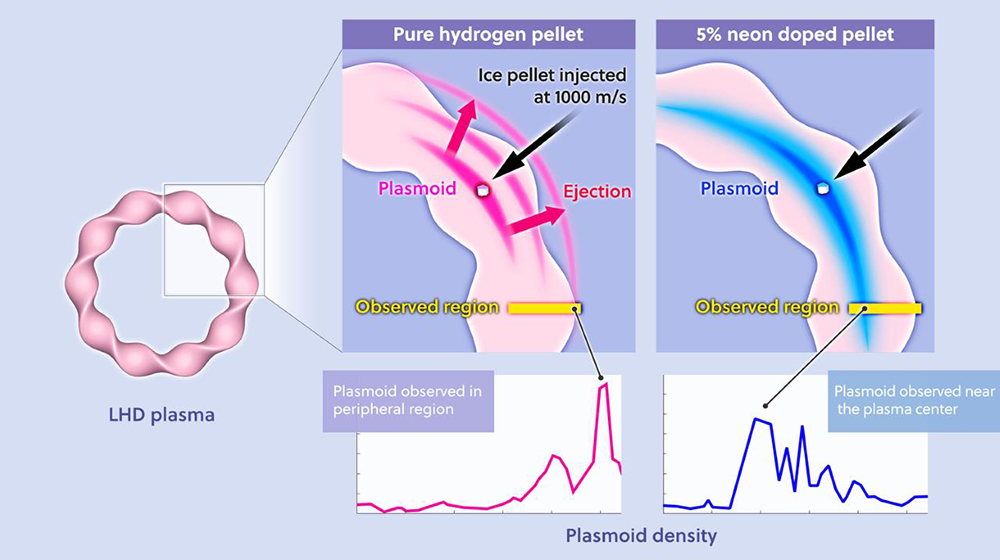Detailed observation of ice melting and assimilating in high-temperature plasma - discovery of effective plasma cooling scheme
The Large Helical Device demonstrated effective plasma cooling at a deeper depth using hydrogen-neon mixture ice pellet injection. In ITER, the world’s largest experimental fusion reactor under construction through international cooperation, requires a forced cooling system to avoid or mitigate damage to the device owing to unintended plasma instabilities. In our experiment, by observing the melting and assimilation of mixed ice pellets of hydrogen and neon in high-temperature plasma, an important physical mechanism that affects the performance of the forced cooling system in ITER was discovered.

In the fusion power plant, the fusion reaction between deuterium and tritium is maintained by heating the fuel to a temperature of 100 million degree. Because there is no material that can withstand such high temperature, the fusion core plasma is controlled so that it does not touch the material wall by using a magnetic field structure called “divertor.” ITER (“The Way” in Latin), which is now under construction at Saint-Paul-les-Durance (France) through the international cooperation, including Japan and will be the first tokamak device to realize “burning plasmas”, relies on this concept.
ITER will tackle many challenges in the operation of the largest magnetic fusion device in history. Therefore, exceptional handling is the most important function of the device to achieve the mission goal. A major concerned event is “disruptions,” where the magnetic configuration to confine the plasma is distorted by macroscopic instabilities. The plasma energy then flows onto the surface of the material wall within a short timescale of a few milliseconds. The heat and electromagnetic loads associated with a disruption may damage the in-vessel components and severely affect the operation cycle and machine lifetime of ITER.
To mitigate this risk, the development of a rapid shutdown system has been a key research area for the last 20 years. Recently, ITER has made a decision on the baseline concept of the scheme applied to ITER – “Shattered Pellet Injection (SPI)”. When a precursor of the plasma instability is diagnosed, the control system will inject ice pellets accelerated to approximately 500 m/s into the high-temperature plasma and cool the target plasma.
Because the reliability of this system is of critical importance for the operation of ITER, we need to know the cooling process with the pellets as detailed as possible and to design what kind of element should be injected into the plasma and in what amount. To contribute to the R&D of the ITER SPI, the Large Helical Device (LHD) performed a new experiment that injected an ice mixture of 95 % hydrogen and 5 % neon. Similar experiments have been conducted in other countries, but the feature of our experiment is that laser diagnostics were used to observe in detail the behavior of ice injected into the high-temperature plasma.
The ice injected into the high-temperature plasma melts from the surface and evaporates and ionizes due to heating by the high-temperature plasma, creating a low-temperature, high-density plasma mass (hereinafter referred to as "plasmoid") around the ice. Such a plasmoid assimilates into the background high-temperature plasma, thereby effectively cooling the whole plasma. In a previous study using pure hydrogen ice pellets, it was observed that plasmoids were ejected before they assimilated into the plasma, and such ejection significantly degraded the effectiveness of plasma cooling. Our experiments yielded the finding to overcome such degradation, which shows that plasmoid ejection can be suppressed by mixing a small amount of neon in hydrogen ice pellets. For this observation, the world’s highest performance in measuring plasma temperature and density using a laser (temporal resolution of 20 kHz), recently developed by NIFS, was exploited.
The results of this study show for the first time that the injection of a small amount of neon added to hydrogen ice affects the assimilation process and is useful for enhancing plasma cooling efficacy. The effect of this neon addition discovered here is not only an interesting new phenomenon obtained experimentally but also an important effect that affects the performance of the forced cooling system. The final design review of the ITER's forced cooling system is scheduled for 2023, and this achievement will help improve the performance of the system and contribute to the establishment of a method for controlling the high-temperature plasma in future fusion reactors.
This research was conducted by Matsuyama Akinobu at Rokkasho Fusion Institute of the National Institutes for Quantum and Radiological Science and Technology (QST), in cooperation with Sakamoto Ryuichi and his research group at the National Institute for Fusion Science (NIFS).
The above study was published in Physical Review Letters, a journal by the American Physical Society on December 15, 2022.
Publication
Related articles: "Cooling 100 million degree plasma with a hydrogen-neon mixture ice pellet" (EurekAlert)
